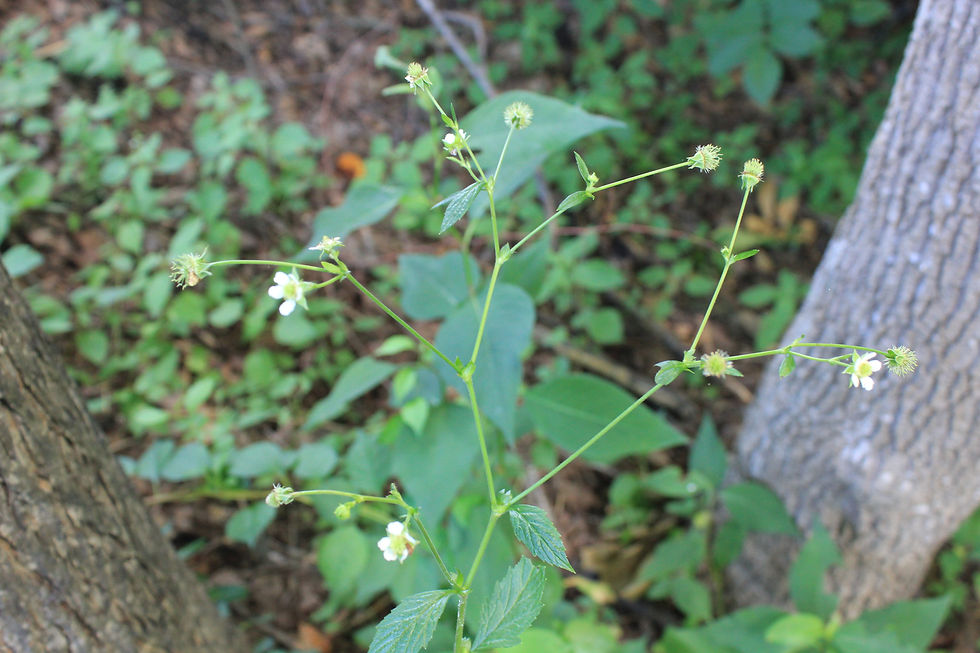A Year in the Life of Pimmit Run: Midsummer, Part I
- barbararyan9
- Jul 3, 2021
- 4 min read
It is now early July, forbs are flowering, and the forest floor is full. There is more going on than can be captured in a single summer blog. Hence, this is the first installment of a summer series, focusing here on stream valley happenings in the basic mesic forest and floodplain.
Up in the forest, the terrain is incredibly lush, but I can already tell that this is not a typical summer. At this time of year, the forest hillside is typically thick with the foliage and white spike blooms of Black Cohosh (Actaea Racemosa) -- but this year much of it appears to be afflicted by a leaf spot illness and there are few flowers. What's going on? The native flora seems to come and go in waves. One year the hillside is covered with a particular forb and the next year another takes over, and so on. Such is the cycle of nature. Here is one of the few Black Cohosh blooms so far and the leaf spot. Could be the cohosh is not taking well to the sporadic droughts, heat waves, and heavy deluges we have seen this summer. Hopefully only a temporary issue.
Like the Black Cohosh, White Snakeroot (Ageratina altissima) tends to dominate the mesic basic forest some summers. Time will tell if it takes over this year, now that the Black Cohosh is in abeyance.

I'm discovering many new forbs in the forest and floodplain that I had not observed previously. Such are the rewards of regular forest visits. But there is more going on. The native seed bank provides gifts at its own pace. It is so gratifying to see a new member of the natural community rising from its underground native seed bank habitat and realize that it really belongs there and was just waiting for the right time to appear. What may appear random is not, not really
I previously had not seen the flowers of the White Avens (Geum canadense) which hugs the ground in the winter with its evergreen basal leaves. The basal leaves are covered by other flora in the summer but its tiny white flowers rise up above it all. This year I am seeing a lot of White Avens flowers -- must be having a banner year.

And I was thrilled to recently encounter a stand of St. John's Wort -- either Spotted St. John's Wort (Hypericum punctatum) or Spotted St. John's Wort (Hypericum mutilum) - on the forest hillside along a frequently-used pathway. The yellow flowers made it unmissable. And I am 100% sure it was not there before, at least not above ground. It is a bona fide member of the natural community, so I suspect it has been lingering below ground waiting for the right moment to make its appearance. I appreciated it. Hopefully there is more on the way.

Ok, I admit it -- I am obsessed with foraging in the forest. Actual edible berries were the next cool discovery. Bramble vines are everywhere in the forest and floodplain, but it can be difficult to know if they are truly native. I always leave them in place now, just in case, and it isn't until they fruit that I can really identify them. Below is Common Dewberry (Rubus flagellaris) which has fruit that ripens to resemble blackberries. Highly medicinal and most definitely edible. Super happy to have it nearby.
Vivid lilac flowers cannot fail to catch the eye in the green opulence. Close to the streambank, I came across stands of Naked-Flowered Tick Trefoil (Hylodesmund nudiflorum) blooming in abundance, although it is so dainty it can be quite easy to overlook. The bright lilac pea-shaped flowers and their little faces appear on single leaf-less stems. Here it is comingling with American Hog Peanut (Amphicarpaea bracteata), another ubiquitous but dainty forest floor habitant.

The next discovery was particularly sweet because it appeared along a portion of the streambank that I am trying to rehabilitate. A streamside area that had become compacted and bare due to trespassing is now host to, among other natives, a stand of Indian Tobacco (Lobelia inflata), a very pretty annual native that reseeds itself. Although it was once used medicinally and smoked by American Indians, it is now thought to be poisonous to humans and mammals. At least that means it's probably safe from deer.

While on the subject of my restoration habitat project, there are lots of native species repopulating the riparian buffer, which was formerly bare and compacted, but now firmly on the mend. Stage one of the project is a "soft" strategy to repopulate the riparian buffer with native woody and groundlayer species. This, as shown below, is well underway. Stage two, which I pray will come soon but the timing is out of my hands, would involve a "hard" solution to bolster and regrade the eroded vertical streambank with nearby rocks and fallen tree stumps, and replant it with live stakes and more native species.

This is what it looked like in late winter. There has been some more streambank erosion, and a few more boulders have taken the leap due to heavy storms, but hoping that help for that is on the way.

Many new arrivals have popped up along the riparian buffer now that foot traffic has ceased. Here is a sample (in addition to the Indian Tobacco) of what I observed in early July, in rows:
Row 1- Deer-Tongue Grass (Dichanthelium clandestinum), Smooth Solomon's Seal (Polygonatum biflorum), White Grass (Leersia virginica)
Row 2 - Horsebalm (Collinsonia canadensis), Calico Aster (Symphyotrichum lateriflorum), American Jumpseed (Persicaria virginica)
Row 3 - Honewort (Cryptotaenia canadensis), Enchanter's Nightshade (Circaea lutetiana), Swamp Agrimony (Agrimonia parviflora)
Immensely gratifying to see habitat restoration in action. Amen.






























Comments